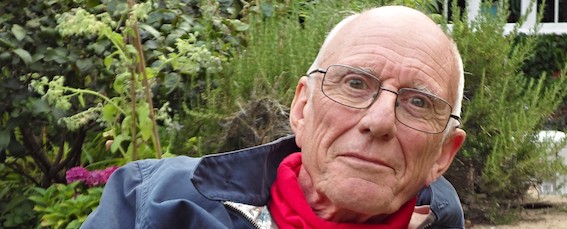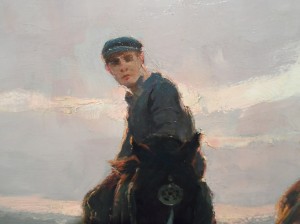Lovely WW1 (and other) horse art
The St Barbe Museum and Art Gallery in Lymington always boxes above its weight and its current show, “Home Lad Home, the War Horse story” is no exception. It isn’t an enormous display, but it is very moving on several counts, and not least its beauty and – more surprisingly – its positivity. This show and the fine town which houses the gallery make a wonderful away-day.
If you have heard of Lucy Kemp-Welch, Edwin Noble, Lady Butler, Joseph Walter West, Lionel Edwards and Cecil Aldin – all of whom star in the Lymington show – then you may know more about animal painting – or indeed painting in general – than me. (Neither would be difficult.) I’d say that Lucy Kemp-Welch is amongst the very best British painters of the period. Maybe she was just too genre – horses and their riders, mostly – to appeal to the art establishment. With Laura Knight, (who importantly painted in the next world war) she shared a love of gypsies and circuses. If you’ll forgive the post-modern spin: in a way, an interest in animals, gypsies and circuses is often – as it was for Dickens – a trope or metaphor for anti-Gradgrind bohemianism. Anyway, LKW’s interest in these themes can be seen in her very fine Gypsy Horse Drovers, in the Russell-Cotes museum in Bournemouth (where Kemp-Welch was born in 1869).
Kemp-Welch’s portrayal of animals is very good, of course. And yet I think it is her handling of riders and the wider human horsey world which shows how strong she is. Of her handful of painting in Lymington, I’d direct you to get close to the Mixed Company at a Race Meeting (1904). There’s all sorts here, including the kind of heavy horse – the punches and jumpers – which would be at war in 1914. But when you look behind the animals, a few vivid, eloquent touches bring us gentry and others, gaudy in the background.
Equally, get close to Burnt Out Fires – her World War 1 painting of horses at the front, the show’s theme – and you see the weary soldier is done in a few brush strokes. But he leaps off the canvas, and especially his expression. I hope the detail posted here, naughtily snapped by RDN, conveys some of the quality of LKW’s work. At the scale of reproduction in its online presentation at the BBC/PCF “Your Paintings” site, you can’t really get a sense of that.
We come now to the way that the “Home Lad Home” show is sad. Well, yes it is. But I resist banging on about that when I comment how strong it is. There is strength here, in horse and human. I hesitate to talk about the strength of character of animals, but it seems to me that the humans here seem indomitable and even, sometimes, humorous. They are vets and grooms (the latter women and girls as well as males), and troops, mounted and not, who are of all classes and status whether at home or at the front. There are booted and spurred cavalry men, a very few of whom are able to charge in the immemorial way, but most riders are reduced to being hauliers. The point is that none are sentimentalised, in the art or the show’s presentation, any more than are the men and women featured in the Stanley Spencer show now gracing the Pallant in Chichester.
Like the Spencer, the Lymington show has some paintings which remind us of the powerful desire parents feel to make remembrance art (or commission it, in the case of Spencer). Lady (Elizabeth) Butler did a lovely little drawing of her son Patrick as she visited him on the eve of embarkation for the front from one of the great horse capital of the war, Lyndhurst. She writes about it all beautifully too, as can be seen in her Autobiography, available at the Gutenberg Project. (This notes, by the way, that this is a Roman Catholic family, as is Paul Richey’s. Another Butler sibling had just become a priest. Patrick, by the way, survived to write his own memoir (now online). The show tells us that these men and their service are memorialised in the Catholic church in Lyndhurst and indeed the whole display links the art to the area whilst not losing the bigger picture.)
I wish I could tell you a lot more about Edwin Noble. His watercolours and drawings strike me as very powerful, and almost all are understated. There is something of the touch of an Eric Ravillious or a Rex Whistler. But also, I found a strong vibe of the Dobbin reading books I knew at kindergarten. So I confess that in the very line of some of the horses’ heads, I am tugged-at. That only adds to my response to what I take to be the seriousness of this work, both in its desire to convey the horses and men, and in its artistry.
I can find little about Noble, but gather he was a Hampshire man and – I vaguely recall from the show’s information boards, which I stupidly didn’t photograph – that he was a serving horseman who was called-on to draw when his skill was discovered. Online, you might find his Springer Spaniel “Gordon” or, more certainly, his Natural History Number 4 (a dog with sheep) at the London Transport Museum site. Best of all, there is his The Dog and Its Reflection, an illustration of Aesop’s Fables from a 1920s book I fancy tracking down. All speak to my childhood memories of this genre. I am shocked at how little of Edwin Noble’s work can be found online at either the BBC/PCF or the Imperial War Museum sites. The latter shows his Purchase of Horses in America, and it is a great beginning, but the others of their holdings are greyed-out (I’ll ask them why, probably).
All in all, this is such a lovely show, with so many layers to its interest, that I wish it had a catalogue.



Leave a comment